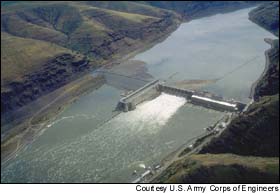forum
library
tutorial
contact

Lessons for Snake River Dams
in the Klamath Basin Agreement
by Rebecca WodderThe Seattle Times, October 25, 2009
|
the film forum library tutorial contact |

|
Lessons for Snake River Dams
by Rebecca Wodder |
 CALL it a tale of two rivers. On the one hand, there is the Klamath, flowing through Oregon and California, where after decades of battling over water, salmon, jobs and livelihoods, stakeholders have come to an agreement to resolve differences and put the river and its fishing, tribal and farming communities on a path to recovery. The centerpiece of that agreement is a plan to remove four outdated dams and replace their limited benefits.
CALL it a tale of two rivers. On the one hand, there is the Klamath, flowing through Oregon and California, where after decades of battling over water, salmon, jobs and livelihoods, stakeholders have come to an agreement to resolve differences and put the river and its fishing, tribal and farming communities on a path to recovery. The centerpiece of that agreement is a plan to remove four outdated dams and replace their limited benefits.
On the other hand, there is the Northwest's Columbia-Snake river basin, where despite the claims of former NOAA Fisheries' regional administrator Will Stelle ["Migrating toward consensus on salmon," Opinion, Oct. 18], inclusive stakeholder negotiations have never been convened and declarations of "consensus" are not based in reality.
But negotiations similar to those that took place in the Klamath Basin are exactly what's needed on the Columbia-Snake. And, as on the Klamath, the future of four dams -- in this case, the four on the Lower Snake River -- should be at the heart of those negotiations.
Once abundant, the Columbia-Snake basin's salmon and steelhead -- an icon and economic driver of the Northwest -- now teeter on the brink of extinction. After the construction of dozens of large dams on the Columbia and its tributaries, the four lower Snake River dams were the proverbial straw that broke the camel's back. The dams kill young salmon on their migration to the ocean, or leave them weakened and vulnerable to disease and predators. The dams also generate power and allow farmers to transport grain downriver.
Federal taxpayers and Pacific Northwest electricity ratepayers have poured more than $8 billion over the past 30 years into an unsuccessful effort to overcome the reality that the Lower Snake River dams -- at least absent major (and even more expensive) changes in water management and dam operations -- are incompatible with healthy salmon runs. After all of this time and money, key wild salmon and steelhead stocks are in no better shape now than when they were first granted federal protection under the Endangered Species Act in the early 1990s.
Extinction of these salmon is not an option, but neither is harming the regional farm economy or failing to ensure that the region has an affordable, reliable and increasingly clean supply of electricity. On the Columbia-Snake, we need an honest consideration of all options, including removal of these four dams, or unprecedented changes in their operation.
Studies show that the grain transportation currently provided by these dams can be affordably replaced by upgrading railroads, highways and access to Columbia River barges, and that cost-effective energy alternatives are available that will help the region do its share to fight global warming.
As all of us who worked to hammer out the Klamath River dam removal agreement will attest, changing status-quo river management on the Columbia and Snake won't be easy -- but nothing worthwhile ever is. Resolving this decades-long controversy will pay off for leaders who are willing to tackle some thorny but solvable issues.
Fortunately, there may soon be an opportunity to take a new approach, as a federal judge in Oregon who has already tossed out two previous, similarly insufficient salmon plans is now reviewing the latest iteration. If the judge rejects this latest plan, we hope it will signal to the Obama administration that a completely new approach is needed. Either way, the administration should call for a comprehensive dialogue among all parties that honestly explores all of the options.
When President Obama took office, he pledged to restore science to its rightful place and properly enforce our nation's bedrock environmental laws. The Klamath can be a model for how to move beyond the arguments of the past and create positive change for today's communities and future generations. This is exactly what the people of the Columbia-Snake basin need.
learn more on topics covered in the film
see the video
read the script
learn the songs
discussion forum
